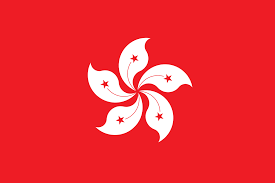Hong kong flag Colors Code hex, png svg
Hong Kong Flag: History, Colors, and Meaning
History
The flag of Hong Kong was adopted on July 1, 1997, when the sovereignty of Hong Kong was transferred from the United Kingdom to the People’s Republic of China. This marked the establishment of the Hong Kong Special Administrative Region (HKSAR). The design of the flag was the result of a competition held in 1987, and it was officially unveiled in 1990. The flag was designed by architect Tao Ho.
Design and Colors
The Hong Kong flag features a white, five-petal Bauhinia blakeana flower in the center of a red field. Each petal contains a red, five-pointed star with a red trace. The flag’s proportions are 2:3.
- Red Field: The red color of the flag is the same as that of the national flag of China, symbolizing the connection and unity between Hong Kong and mainland China.
- White Bauhinia Flower: The Bauhinia blakeana is a native flower of Hong Kong, representing the region’s unique identity and culture. The white color of the flower contrasts with the red field, symbolizing harmony and balance.
- Five Stars: The five stars within the petals of the Bauhinia flower reflect the design of the Chinese national flag, further emphasizing the link between Hong Kong and China. The stars also represent the socialist values under China’s governance.
Meaning
The Hong Kong flag embodies the principle of “one country, two systems,” under which Hong Kong maintains a separate legal and economic system from mainland China. The red and white colors signify harmony, unity, and the region’s distinct identity. The Bauhinia flower, a symbol of Hong Kong, highlights the region’s heritage and its unique position within the People’s Republic of China.
In summary, the flag of Hong Kong is a powerful symbol of the region’s identity, its connection to China, and the unique “one country, two systems” framework that defines its governance and cultural landscape.
Guess the Flags Quiz
Sharing is caring 🤗

National Symbols 👇
- 🏁 National Flags
- 🦁 National Animals
- 🐦 National Birds
- 🌻 National Flowers
- 🌴 National Trees
- 🥭 National Fruits
- 🍹 National Drinks
- 👴 National Founders
- ☘️ National Emblems
- 🍲 National Dishes
- 🏛️ National Monuments
- ✍️ National Poets
- 🕌 National Mausoleums
- 🎺 National Instruments
- 🦸 National Heroes
- 📆 National Days

